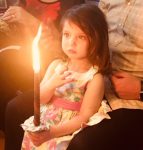Mia holds a Havdalah candle. (photo by Miriam Leo Gindin)
Many Orthodox Jews wait until a boy’s third birthday before giving him his first haircut in a ritual called upsherin, a Yiddish word meaning to “cut off.” In recent years, this custom has spread outside of the Orthodox world to be embraced by other Jews and, as a recent upsherin in Vancouver showed, some are beginning to include girls in the custom as well.
On March 17, Noam and Val Dolgin invited family and friends to their house for the upsherin of their daughter, Mia.
“For me, this was an opportunity to connect with tradition. I love the lifecycle traditions of Judaism,” Val Dolgin told the Jewish Independent.
Noting that they had done the same thing for their son Erez, who is two years older than Mia, she said, “I think it’s really important for kids to see themselves as being a part of a multi-generational community that cares about them, that makes them feel safe; that they can know they’re part of something bigger than themselves, that there are lots of people around rooting for them to succeed. For me, it was a chance for Mia to be affirmed in her community, to mark a transition, and to connect with tradition in a way that’s meaningful.”
Val Dolgin’s parents, who did not grow up with the upsherin tradition, were present at the ceremony. “My parents are very proud that they have Jewishly involved children,” she said. “They had never been to an upsherin before Erez and Mia’s. For them, they enjoy any opportunity to celebrate their family.”
Traditionally, the upsherin marks when, at the age of 3, a boy officially begins his Torah education and starts to wear a kippah and tzitzit. It was first mentioned in Sha’ar HaKavonot by Rabbi Chaim Vital, a student of 16th-century kabbalist Isaac Luria. The ceremony’s origins are mystical, and it was seldom observed outside of the Orthodox world until recently. The traditional ritual includes the haircut (leaving peyot), eating cookies shaped like Hebrew letters and dipped in honey (to show learning is sweet) and the wearing of tzitzit and a kippah for the first time.
The idea of three years as the transition time derives from the mitzvah of orlah. The Torah says that if you plant a tree, all fruits that grow during the first three years are orlah, or off limits (Leviticus 19:23). Given the kabbalistic comparisons of people to trees, many Orthodox Jews leave a child’s hair uncut during the first three years.
“The ritual of upsherin was special for us on a few levels,” said Noam Dolgin. “First, the ecological connection, which reminds us that we are part of nature. Two, it marks an important transition from baby/toddler to child. And, lastly, it is an important moment when our child is old enough to start learning and internalizing Jewish and communal values and mitzvot.”
He added, “I believe the practice has even more significance today as we better understand child development and re-explore our ecological connections. And, of course, we would do it for our daughter – it’s just as relevant to her development and place in our community as it was our son.”
“The upsherin marks a Havdalah between freest babyhood and, at age 3, the first increment of teaching and training a child,” said Or Shalom spiritual leader Rabbi Hannah Dresner, who led the ceremony. “What a great ritual to promote and renew! For us, of course, it is an egalitarian marking of readiness. Traditionally, the first snip is taken from the centre of the forelock, the place of the third eye or of insight, the spot that will, someday, at the next big milestone of readiness, receive the tefillin shel rosh, the tefillin box that sits on the forehead. For those in progressive Jewish circles, kippah, tzitzit and tefillin are all ritual wear promoted for girls and boys alike. The upsherin can be a sweet, celebratory beginning of Jewish education and the beginning of mitzvah-doing in the lives of all our children.”
Matthew Gindin is a freelance journalist, writer and lecturer. He is Pacific correspondent for the CJN, writes regularly for the Forward, Tricycle and the Wisdom Daily, and has been published in Sojourners, Religion Dispatches and elsewhere. He can be found on Medium and Twitter.

